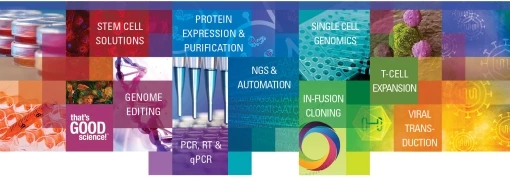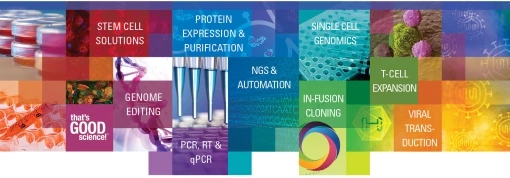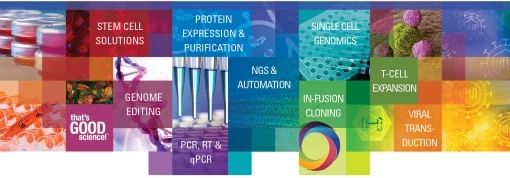WEBINARIUM: NEW APPLICATIONS LEVERAGING SMART TECHNOLOGY FOR NEXT-GEN SEQUENCING
31 Października 2017 (Ostatnia aktualizacja 23.10.2024)
Szanowni Państwo,
Serdecznie zapraszamy na webinarium poświęcone systemom do sekwencjonowania nowej generacji NGS, opartym na technologii SMARTer.
Technologia wykorzystuje niezwykły enzym odznaczający się dwiema specyficznymi cechami. Odwrotna transkryptaza SMART ma zdolności terminalnej transferazy oraz przełączania matrycy. Po zakończeniu przepisywania odcinka RNA do końca 3’ dołącza dodatkowe nukleotydy. Są one następnie rozpoznawane przez primery SMART oligo, służące w następnym etapie reakcji jako nowa matryca dla enzymu (Switching Mechanism at the 5′ end of RNA Template).
Tak przygotowana biblioteka umożliwia równocenną analizę końców 3’ i 5’ analizowanych transkryptów (Ryc1.).

Figure 1. Schematic of technology used by the SMARTer smRNA-Seq Kit for Illumina. SMART technology is used in a ligation-free workflow to generate sequencing libraries for Illumina platforms. Input RNA is first polyadenylated in order to provide a priming sequence for an oligo(dT) primer. cDNA synthesis is primed by the 3′ smRNA dT Primer, which incorporates an adapter sequence (green) at the 5′ end of each first-strand cDNA molecule. When the MMLV-derived PrimeScript Reverse Transcriptase (RT) reaches the 5′ end of each RNA template, it adds non-templated nucleotides which are bound by the SMART smRNA Oligo—enhanced with locked nucleic acid (LNA) technology for greater sensitivity. In the template-switching step, PrimeScript RT uses the SMART smRNA Oligo as a template for the addition of a second adapter sequence (purple) to the 3′end of each first-strand cDNA molecule. In the next step, full-length Illumina adapters (including indexes for sample multiplexing) are added during PCR amplification. The Forward PCR Primer binds to the sequence added by the SMART smRNA Oligo, while the Reverse PCR Primer binds to the sequence added by the 3′ smRNA dT Primer. Resulting library cDNA molecules include adapters required for clustering on an Illumina flow cell (P5 shown in light blue, P7 shown in red), Illumina TruSeq® HT indexes (Index 2 [i5] shown in orange, Index 1 [i7] shown in yellow), and regions bound by the Read Primer 1 or Read Primer 2 sequencing primers (shown in purple and green, respectively). Note that adapters included in the final library add 153 bp to the size of RNA-derived insert sequences [NOTA]
Opisana technologia pozwala także na stworzenie szeregu innych zaawansowanych narzędzi do NGS – takich jak np. do celowanego sekwencjonowania. Takara Bio. stworzyła taki gotowy zestaw. Pozwala on na wyselekcjonowaną analizę transkryptów tylko z określonego zakresu zainteresowania. Ma to szczególne znaczenie kiedy analizowane RNA jest niskokopijne. Zastosowanie SMARTer® Target RNA Capture for Illumina® pozwala na zmniejszenie kosztów i wygenerowanie jedynie specyficznych danych [NOTA].
Podczas webinarium zostanie zaprezentowane rozwiązanie do celowanego sekwencjonwania RNA (targeted RNA sequencing) a także do analizy regulących transkrypcję małych RNA (small RNA sequencing). Omówione zostaną również zestawy znajdujące zastosowanie podczas profilowania limfocytów T i B (T-cell receptor; B-cell receptor sequencing).
.jpg)
Figure 2. T-cell receptor structure and diversification. Panel A. A functional αβ TCR heterodimer consisting of α- and β-subunit chains. TCR α-subunit chains consist of "variable" (V), "joining" (J), and "constant" (C) segments depicted in magenta, blue, and green, respectively, while TCR β-subunit chains include these and an additional "diversity" (D) segment, depicted in orange. The CDR3 region of the TCR β-subunit is labeled. The TCR is depicted on the T-cell surface, bound to an antigen associated with an MHC molecule on the surface of an APC [NOTA]
.gif)
Figure 3. BCR development. The progenitor cell undergoes recombination of V, D, and J segments in the germline, which generates two identical heavy chains. Recombination of V and J segments generates two identical light chains. Random nucleotide additions or deletions at the junctions of the V, D, and J segments provide additional diversity. Furthermore, B cells activated by immune responses undergo somatic hypermutation (SHM), in which additional point mutations are introduced. [NOTA]




